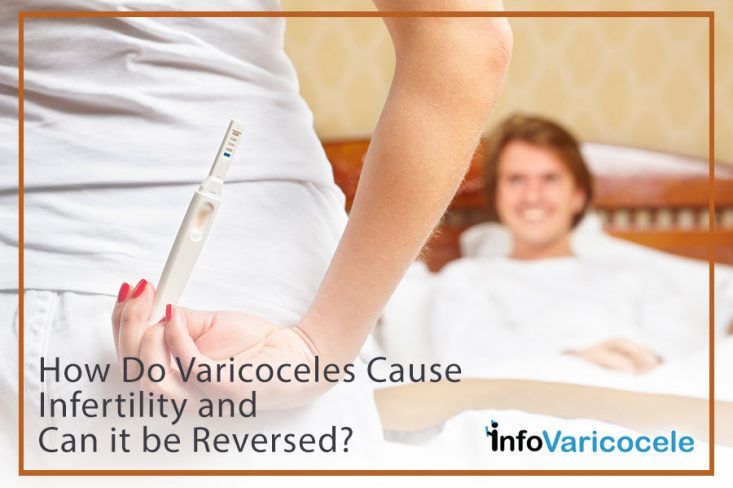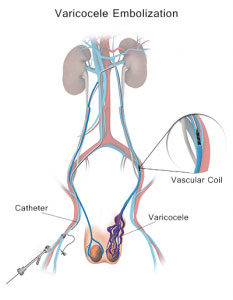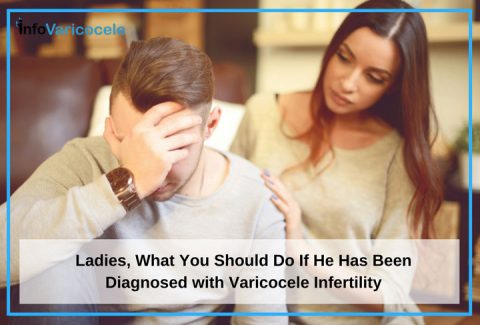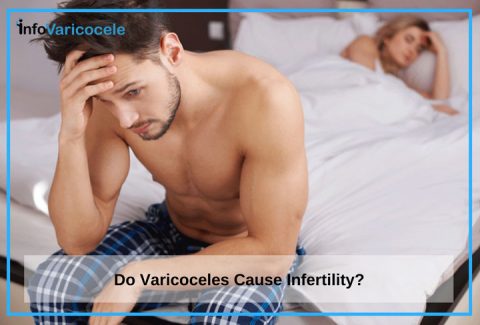
Many men often don’t know they have a varicocele (varicose veins in the scrotum) until they are evaluated for infertility. Infertility is diagnosed when a couple has been unable to get pregnant after at least 12 months of having unprotected intercourse. Infertility is not all that uncommon — it affects about 1 in 6 couples.[i] Varicoceles occur in 15% of all men, and are thought to be involved in up to 40% of cases of infertility.[ii], [iii] The good news is there are varicocele infertility treatment options. So, how does a varicocele cause infertility?
The Link Between Varicoceles and Infertility
The man’s role in fertility is to provide healthy sperm that can travel through the woman’s vagina, into the uterus, and up to the fallopian tubes where one spermatozoon, a single sperm, waits for the woman’s egg, or ovum, to be released. Once an egg is released it can be fertilized and can develop into an embryo, which can eventually grow into a baby. In order to accomplish this, a man needs semen, or ejaculate, that contains enough sperm that are able to move well and fertilize an egg. Having a varicocele can affect this process and can be a cause for infertility.
How Varicoceles Cause Infertility
What is varicocele infertility? Varicoceles raise the temperature of the testicle, which affects the development of sperm.[iv] This increase in temperature has two effects. First, it leads to a decrease in the production of testosterone, which is the male hormone involved in the production of sperm. This decrease in testosterone leads to a reduction to the number of sperm produced and may also lead to defects in the development of the sperm so that the motility, or the ability of the sperm to swim, is impaired. The increased temperature is also thought to lead to a rise in reactive oxygen species, which is said to damage the sperm’s DNA and membrane, or outer coating. All of these effects harm the health of the sperm.
RELATED: 30 Stats About Varicocele Infertility
Reversing Varicoceles
 Varicoceles can be reversed through both surgical procedures and a nonsurgical treatment option. These treatments are designed to decrease the pressure in the varicose veins that make up the varicocele. Varicocelectomy is a surgical procedure that involves tying off the veins that are causing the varicocele. There is also a minimally invasive option, varicocele embolization. Both of these treatments can alleviate the varicocele and lead to improvements in the sperm count and quality. Here is a more detail about the different treatment options:
Varicoceles can be reversed through both surgical procedures and a nonsurgical treatment option. These treatments are designed to decrease the pressure in the varicose veins that make up the varicocele. Varicocelectomy is a surgical procedure that involves tying off the veins that are causing the varicocele. There is also a minimally invasive option, varicocele embolization. Both of these treatments can alleviate the varicocele and lead to improvements in the sperm count and quality. Here is a more detail about the different treatment options:
- Open Varicocelectomy –Open varicocelectomy involves an incision, typically in the groin, to access the blood vessels that are contributing to the varicocele. Then these blood vessels are tied off.
- Laparascopic Varicocelectomy– Laparoscopic varicocelectomy involves three small incisions in the abdomen. One of the incisions is used to insert a laparoscope (scope) into the abdomen. The other two incisions are used to insert the instruments necessary to cut, and tie off the swollen veins. This procedure requires general anesthesia, which means you will be completely unconscious during the procedure.
- Microsurgical Varicocelectomy –Microsurgical varicocelectomy involves an incision in the groin and is similar to open varicocelectomy, except that the surgeon uses a microscope to see the blood vessels. The microscope makes it easier to identify the blood vessels.
- Varicocele Embolization –Varicocele embolization is a minimally invasive, outpatient procedure performed by an interventional radiologist. A small incision is made in the groin for a catheter, a thin tube, which is placed inside the femoral vein. Using x-ray technology to follow the path of the catheter, the catheter is guided into the swollen veins that comprise the varicocele. A small coil is placed inside the veins to block off and redirect the blood to flow through different blood vessels and relieve the pressure. At the end of the procedure, the catheter is removed and a bandage is placed over the small incision.
RELATED: How to Treat Varicocele Infertility Without Surgery
Hopefully you have a better understanding of the link between varicocele and infertility. More importantly, you should be aware of the treatment options that are available to reverse varicoceles. Treatment can be quick and effective in dealing with the challenges of varicocele-related male factor infertility.
Sources:
[i] American Pregnancy Association. Male Infertility: Causes, Treatment and Prevention. http://americanpregnancy.org/infertility/male-infertility
[ii] Choi, W., and Kim, S., Current Issues in Varicocele Management: A Review. World J Mens Health, 2013. 31(1): p. 12-20.
[iii] American Society for Reproductive Medicine, Male Infertility. http://www.reproductivefacts.org/topics/detail.aspx?id=1331
[iv] http://www.ncbi.nlm.nih.gov/pmc/articles/PMC2664231/


